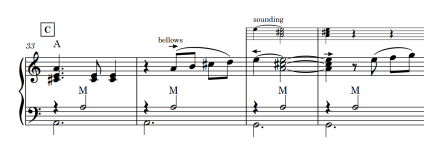JesterMusician
Newbie
Hello! I'm a beginner accordionist, and I'm looking to arrange music that I know I will enjoy learning. I have a good amount of experience arranging and writing sheet music for other instruments, but I'm trying to learn the correct notation and idioms for accordion.
To start, I've been transcribing Kass' Final Song. I use Dorico, and I've configured an expression map to control an accordion VST with the typical Stradella bass notation:
Questions I've got so far:
To start, I've been transcribing Kass' Final Song. I use Dorico, and I've configured an expression map to control an accordion VST with the typical Stradella bass notation:
Questions I've got so far:
- How does it look, visually?
- Are the turn ornaments useful, or are they more confusing than just writing them out in full?
- Is it okay to include chord symbols at the top of each system?
- Is it usual to notate the bass and chords in two voices (such as at rehearsal B), or would ties make more sense?
- How does it feel to play?
- I've got a Roland FR-1xb, so I'm trying to learn CBA, but I'm also curious about how it is on PA. It at least looks reasonable as a piano part.
- Is the difficulty relatively constant? Or are there certain measures that are significantly more difficult than they should be?
- How accurate is it?
- The transcription is based on this version on YouTube, but I'm not sure if I've done it correctly. Do you see any obvious mistakes?
- Do I have the registration correct?
- At 36, I think it is the bellows that rearticulates the tied chord that begins the measure, but I think the player's fingers do not lift. Should I leave it as written, or should I indicate this rearticulation somehow? And if so, do I do that by breaking up the ties, or is there another way?
- Counter-bass is usually indicated with a small dash on the note like a tenuto. I think I've also seen underlines on fingering indications to mean the same thing. If I'm using a 3-3 French bass layout, is there a standard way to indicate whether the second counter-bass row should be used?
- On the treble side, is there a standard way to indicate which row to use on a CBA (e.g. C in the 1st row vs. C in the 4th row?) On a violin, this would be indicated with roman numeral corresponding to which string to use, but I don't think that would make sense here.
- In piano music, circled numbers often indicate that the finger is crossing over. Is this a convention used in accordion music, too?
- Are there standard indications for "pull" and "push"? One of my books has upbow and inverted upbow (respectively), but I've also seen upbow and downbow, and the marks which you can see in the panel on the right of the video, underneath the "d" and the "M". Are these only ever used in teaching materials, or are they sometimes used in real works, too?





